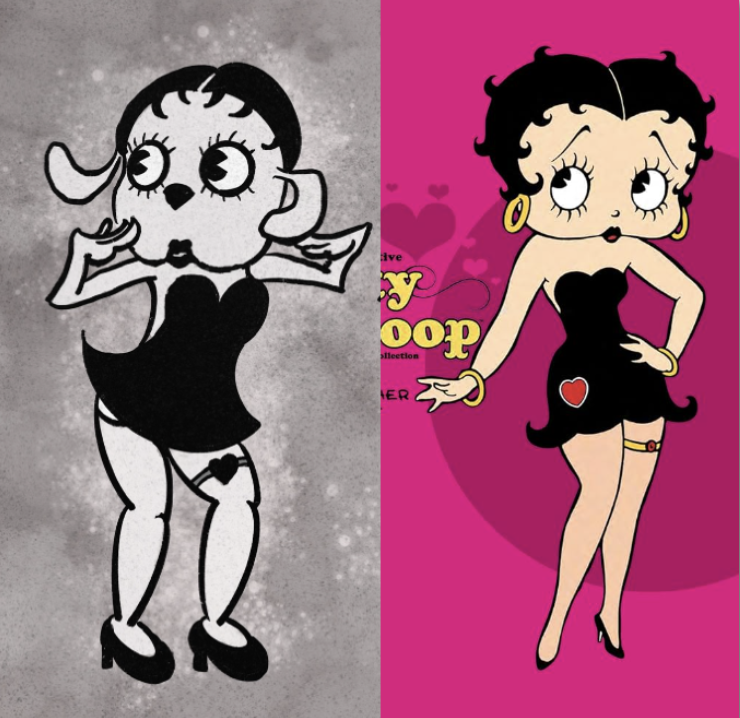Betty Boop is a significant character in the animation world and for society, as she was introduced in 1930 on a cartoon called “Dizzy Dishes.” Betty was brought into the animated and comic world in her original form- as a human-like French poodle. Not only did she end up transforming into a fully human character, but the very first all-human, all-female character in animation.
Since making her character debut in 1930, Betty Boop continues to exist as a cultural icon, representing the empowering and restrictive views on women in society. Her original human form was portrayed as a music-loving flapper (an often-used term to describe a young, fashionable women who showed very independent behavior in the 1920’s) (Bouldin, 2001). As time passed on, Betty’s image changed as her character adjusted to the ever-changing standards for cultural diversity and female representation. At first, Betty Boop was the iconic female representation of the 1920s. She portrayed the untamed femininity of the flapper with her earlier physical appearance that had a more exaggerated and bigger smile as well as her “curvy” shape with a thin waist. In Aylin Gungor’s journal titled “Women’s Sex Representation in Comic Book” she dives into Betty’s appearance. Describing how Betty was “as smart and cute as she is sexy with her big eyes,” while also being different from other female characters that were strictly sexually appealing to the male gaze. Gungor also described how “Betty Boop did not bow to men by encountering events such as harassment that women face in daily life,” making her a more powerful female presence (Gungor 2020).
When the late 1930s came around America had begun to move away from the liberal 1920s, Betty’s character and storylines began to reflect more conservative concepts. Betty’s personality and appearance was changed by the Hays Code, a set of harsh rules for the film business that came into effect in 1934 and enforced limits on depictions of sexuality. In a journal titled “Gender and Cartoons from Theaters to Television: Feminist Critique on the Early Years of Cartoons” by Author Katia Perea, she states that “The Hays Code sanitized the vampish Betty Boop from a raunchy, hip-swaying flirt who owned a business.” Her strong wording gives a clear explanation on the level of strictness that was brought down on the way female characters were allowed to be portrayed (Perea 2018). Betty was then shown as a more humble character, with fewer risky storylines, signifying that she was moving away from her flapper origins. Betty’s reputation as an empowered, independent woman had been knocked back by this change, which represented society’s attempt at limiting female sexuality in the public media.
In more modern society Betty Boop has been reinvented as a feminist icon in current representations. These modern portrayals of Betty Boop celebrate her independence and sexual confidence as more admirable traits instead of making them seem bad like the Hays Code governing in the 1930’s. Betty’s initial traits as a character who pushes boundaries are often brought out in modern theories, such as merchandising and animated revivals. Grungor discusses the modern portrayal of female animated characters, saying that it has evolved over time and “represents the limitlessness of women to express themselves as a gender,” (Gungor 2020). This modern recognition shows how Betty’s character has changed from a limited stereotype to a representation of feminist strength.
As for the animated French poodle that was Betty Boop’s original form, that remains long forgotten because of the strong impact the very first human female character had on society and feminist culture. The transformation of Betty Boop from a flirty flapper to a feminist icon shows how the changing views of society regarding gender and the portrayal of women. Modern visuals of Betty recover her courage, independence, and sexuality as empowering traits, although the Hays Code of the 1930s had been trying to restrict her expression. Betty Boop serves as a reminder of the constant battle for women expressing themselves. Her lasting impact makes sure Betty Boop will be a long-lasting cultural and feminist icon.
Bibliography
Bouldin, Joanna. “The body, animation and the real: Race, reality and the rotoscope in Betty Boop.” In Conference proceedings for affective encounters: rethinking embodiment in feminist media studies, pp. 48-54. 2001.
Gungor, Aylin. “Women’s Sex Representation in Comic Book.” In Proceedings of the International Conference on Future of Women, vol. 3, no. 1, pp. 25-35. 2020.
Perea, Katia. “Gender and Cartoons from Theaters to Television: Feminist Critique on the Early Years of Cartoons.” Animation, 13(1), 20-34. 2018. https://doi.org/10.1177/1746847718755591
Reinsch, Ole. “Flapper Girls – Feminism and Consumer Society in the 1920s.” Gender Forum, no. 42: 1–6. 2013. https://research-ebsco-com.ezproxy.tru.ca/linkprocessor/plink?id=10c8e03c-c32b-3449-b52e-51e1cffdf308.


Brook Harrington
Hi Riley. I quite liked the character you chose to analyse, and Betty Boop was a huge part of the early animation industry. I enjoyed how you went in depth with the history of her character, her cultural significance, and how she was heavily influenced by the Hays Code in the late 1930’s.
I found that some of your sources in your assignment were a bit off. You used Bouldin’s citation to define the word ‘flapper’, but I could not find that definition within the article. Then, in Perea’s article when talking about how Betty Boop was changed, you quoted part of how she was changed to fit the Hays Code. However, there were more changes within the quote that were not included. Also, you mentioned Reinsch’s article in your bibliography, but there were no in-text citations for that article.
The thing I took the most notice of would be which versions of Betty Boop you chose to analyse. You started your analysis by mentioning the original iteration of Betty Boop, a character who was part dog and part human. Then, you continued to talk about how Betty shifted into a new “all human, all female” character, and you talked about her history. However, there was then very little mention of Betty Boop’s original character design, and you even mentioned how Betty Boop’s original form is long forgotten.
Instead of doing a character analysis and comparison with her original design, you could have done a character analysis comparing Betty Boop’s redesigned character due to the Hays Code. You mentioned how deeply the Hays Code impacted her personality and origin, but the Hays Code also impacted her character design, making her less provocative. By analysing this version of her character, you could show how Hollywood was trying to suppress femininity through the media being produced during this time.
Riley
Hi Brook, I appreciate the feedback! I found where I went wrong on my citations as well and will fix that before my final submission.